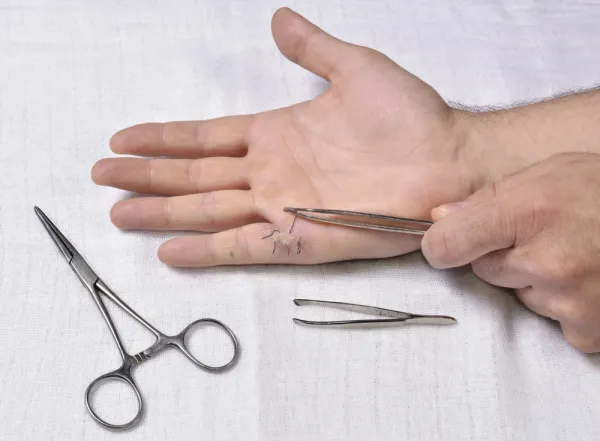Marginal Removal Smarts Might Mean Missed Money

Guess what you need to add to total removal area before coding?
Lesion excision codes delve into the tenths of centimeters for measurements, but coders that aren't willing to dive down for details could be leaving deserved reimbursement submerged in the encounter notes.
In $hort: The dermatologist excises a benign lesion from a patient's scalp; total removal area is 1.1 cm. You add incorrectly, however, and only code for 0.5 cm of total removal area. Undercoding just cost your practice about $50 on this claim.
Malignancy Question Drives Choices
Choose from the following code sets when your dermatologist performs lesion removal, confirms John F.Bishop, PA-C, CPC, CGSC, CPRC, president of Bishop & Associates, Inc. in Tampa:
• 11400 (Excision, benign lesion including margins,except skin tag [unless listed elsewhere], trunk, arms or legs; excised diameter 0.5 cm or less) through 11446 (Excision, other benign lesion including margins, except skin tag [unless listed elsewhere], face, ears eyelids, nose, lips, mucous membrane; excised diameter over 4.0 cm) for benign lesions, or
• 11600 (Excision, malignant lesion including margins, trunk, arms or legs; excised diameter 0.5 cm or less) through 11646 (Excision, malignant lesion including margins, face, ears eyelids, nose, lips; excised diameter over 4.0 cm) for malignant lesions.
Example: The dermatologist removes a 0.7 cm lesion (including margin) from an established patient's left arm. Pathology report returns revealing benign tissue. On the claim, you'd report 11401 (... excised diameter 0.6 cm to 1.0 cm) for the removal with 216.6 (Benign neoplasm of skin; skin of upper limb, including shoulder) appended to represent the lesion.
Be Sure to Mind This 'Marginal' Issue
Follow these two important rules when coding for lesion excision:
• Include margins in measurements: You're cutting yourself off at the knees if you code based on lesion size. You should actually measure each excision "at the widest diameter, including any margins," explains Bishop.
• Measure lesion size pre-excision: Be sure to make the measurement before the dermatologist removes the lesion, warns Cheryl Starner, revenue integrity analyst for Missouri's Truman Medical Centers. "Do not report [lesion and margin] size from the pathology report," she says. The sample you send to pathology will inevitably be smaller than the one you get back. And a couple tenths of a centimeter can cost the coder half a hundred bucks.
Example: The dermatologist excises a lesion from a patient's scalp; the lesion size, including margins, is 1.1 cm. The coder counts only lesion size, however, so she reports 11420 (Excision, benign lesion including margins, except skin tag [unless listed elsewhere], scalp, neck, hands, feet, genitalia; excised diameter 0.5 cm or less) when she should have reported 11422 (... excised diameter 1.1 to 2.0 cm).
Fallout: The 11420 code pays about $107 (2.99 transitioned non-facility relative value units [RVUs] multiplied by the temporary 2010 Medicare conversion rate of $36.0846). Conversely, 11422 brings in about $157 (4.33 RVUs multiplied by $36.0846).
Add Modifiers in Some Situations
When the dermatologist removes multiple lesions from the same patient, you should report each excision separately. CPT guidelines preceding each lesion excision section state: "Report separately each benign [or malignant] lesion excised."
Depending on the nature, size, and location of the lesions, you may need to put modifiers to use on multiple lesion removals.
Example: The dermatologist removes a pair of lesions from a patient's left cheek; the first lesion (including margin) is 0.4 cm and the second is 0.3 cm. Pathology reveals both growths are melanoma.
On the claim, you'd report 11640 (... excised diameter 0.5 cm or less) on two lines with 172.3 (Malignant melanoma of skin; other and unspecified parts of the face) appended to represent the patient's cancer.
To indicate that the second instance of 11640 on the claim is a distinct service, append modifier 59 (Distinct procedural service).
If the lesions are in different anatomic areas -- or if the lesions differ in pathology -- you'll code the removals separately without any modifiers.
Example: An established patient reports to the dermatologist with two pigmented neck lesions. After a level-two E/M service, the dermatologist performs 0.4 cm removal on one lesion and a 0.2 cm removal on the other. Pathology report returns revealing that the larger lesion was malignant, while the smaller one was benign.
On the claim, report the following:
• 11620 (Excision, malignant lesion including margins, scalp, neck, hands, feet, genitalia; excised diameter 0.5 cm or less) for the malignant lesion removal,
• 172.4 (Malignant melanoma of skin; scalp and neck) appended to 11620 to represent the patient's malignant neck lesion,
• 11420 (Excision, benign lesion including margins, except skin tag [unless listed elsewhere], scalp, neck, hands, feet, genitalia, excised diameter 0.5 cm or less) for the benign lesion removal,
• modifier 51 (Multiple procedures) appended to 11420 to show that the second removal was additional, if the payer requires it,
• 216.4 (Benign neoplasm of skin; scalp and skin of neck) appended to 11420 to represent the patient's benign lesion,
• 99212 (Office or other outpatient visit for the evaluation and management of an established patient, which requires at least 2 of these 3 key components: a problem focused history; a problem focused examination; straightforward medical decision making ...) for the E/M,
• modifier 25 (Significant, separately identifiable evaluation and management service by the same physician on the same day of the procedure or other service) appended to 99212 to show that the E/M was a significant, separate service from the lesion removals, and
• 172.4 and 216.4 appended to 99212 to represent the patient's condition.

